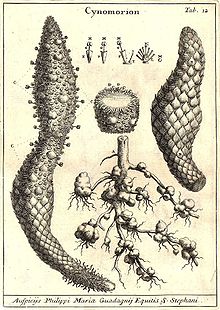Cynomorium
| Cynomorium | ||||||||||||
|---|---|---|---|---|---|---|---|---|---|---|---|---|

Maltese sponge ( Cynomorium coccineum ) |
||||||||||||
| Systematics | ||||||||||||
|
||||||||||||
| Scientific name of the family | ||||||||||||
| Cynomoriaceae | ||||||||||||
| ( Schott & Endl. ) Lindl. | ||||||||||||
| Scientific name of the genus | ||||||||||||
| Cynomorium | ||||||||||||
| L. | ||||||||||||

Cynomorium is the only genus of the family of the Maltese sponge plants . They are full parasites (holoparasites).
description
The Cynomorium species are perennial herbaceous plants that reach heights of up to 30 cm. They are reddish brown plants without chlorophyll . Cynomorium TYPES parasitize as full parasites (holoparasites) with brief historical appendages with Xylem - and Phloemanschluss at the roots of salt-tolerant plants ( halophytes ): The main host plants are at Cynomorium coccineum Atriplex TYPES and cynomorium songaricum Nitraria sibirica , Reaumuria species, Salsola TYPES and Tamarix species. There is no secondary growth in thickness. They have subterranean, branched, brownish rhizomes as persistence organs. The upright, unbranched stems are fleshy. The alternate and spirally arranged leaves on the stem are reduced to triangular to lanceolate scales.
Cynomorium species are monoecious ( monoecious ). The terminal, spiked or heady inflorescence is brown-red. The individual flowers are in the axils of triangular, scale-shaped bracts . The mostly unisexual, rarely hermaphrodite, small flowers are scarlet red. The usually three to four (one to eight) bracts are reduced to lobed appendages and are free to fused. Sometimes the bracts are missing in female flowers. The male flowers have only one stamen and one rudimentary ovary. Two carpels are fused together to form a hanging ovary below; it contains only one ovule .
The small, spherical nut fruit contains only one seed.
Name and botanical history
The scientific generic name was established by Pier Antonio Micheli in his book Nova plantarum genera in 1729 . The spelling Cynomorion used there shows the Greek origin of the word (kynomorion = dog penis). Carl von Linné then changed the name in his Materia Medica (1749) to Cynomorium . Before the 18th century, the plant was mostly thought to be a mushroom. Paolo Boccone, for example, referred to it as the Fungus Typhoides coccineus Melitensis , that is, a "cattail-like, scarlet mushroom from Malta".
Systematics and distribution
The systematic affiliation of the family to the Saxifragales was only clarified through molecular data in 2016. Until then, they were not assigned to any order in the Angiosperm Phylogeny Group 2009 system.
The family Cynomoriaceae consists - depending on the opinion - of one genus with two species or one species with two subspecies. Their area stretches continuously from western China to the Canary Islands (see distribution map based on herbarium collections in Cusimano and Renner, 2019).
- Maltese sponge ( Cynomorium coccineum L. )
- Cynomorium songaricum Ruprecht (Syn .: Cynomorium coccineum subsp. Soongaricum (Rupr.) J.Léonard ), isnative tosouthwest and central Asia . The area extends from Iran via Afghanistan to Mongolia and the Chinese provinces of Gansu, Nei Mongol, Ningxia, Qinghai, Shaanxi, Xinjiang. Cynomorium songaricum thrives on the edge of standing, sometimes only temporary, and flowing waters in deserts. In China, Cynomorium songaricum thrivesat altitudes between 500 and 700 meters.
use
Both types are used medicinally.
Cynomorium songaricum is used in Chinese medicine under the name "suǒ yáng" (鎖陽 / 锁阳). The Maltese sponge ( Cynomorium coccineum ) is sometimes used as a substituent for the other species.
Individual evidence
- ↑ Bellot, S., N. Cusimano, G. Sun, SX. Luo, S. Zarre, A. Gröger, E. Temsch, and SS Renner. 2016. Assembled plastid and mitochondrial genomes, as well as nuclear genes, place the parasite family Cynomoriaceae in the Saxifragales. In: Genome Biology and Evolution Vol. 8, No. 7, pp. 2214-2230, doi : 10.1111 / j.1095-8339.2009.00996.x
- ↑ Angiosperm Phylogeny Group : An update of the Angiosperm Phylogeny Group classification for the orders and families of flowering plants: APG III. In: Botanical Journal of the Linnean Society. Vol. 161, No. 2, 2009, ISSN 0024-4074 , pp. 105-121, doi: 10.1093 / gbe / evw147 .
- ↑ a b Rafaël Govaerts (Ed.): Cynomorium. In: World Checklist of Selected Plant Families (WCSP) - The Board of Trustees of the Royal Botanic Gardens, Kew . Retrieved April 19, 2020.
swell
- The family of Cynomoriaceae in APWebsite (Engl.)
- The Cynomoriaceae family at DELTA by L. Watson & MJ Dallwitz. (engl.)
- The Cynomoriaceae family at www.parasiticplants.
- Subhuti Dharmananda: Cynomorium - Parasitic Plant Widely Used in Traditional Medicine Online.
- Jiarui Chen & Michele Funston: Cynomoriaceae in the Flora of China , Volume 13, p. 434, 2007: Online.
- Rubina Rafiq: Cynomoriaceae in the Flora of Pakistan: Online.
- Natalie Cusimano and Susanne S. Renner, 2019. Sequential horizontal gene transfers from different hosts in a widespread Eurasian parasitic plant, Cynomorium coccineum . American Journal of Botany 106 (5): 679-689.
Web links
- O. Juel: Cynomorium and Hippuris. In: Svensk Botanisk Tidskrift. Vol. 4, H. 3, 1910, ISSN 0039-646X , pp. 151-159, online (PDF; 265 kB) .
